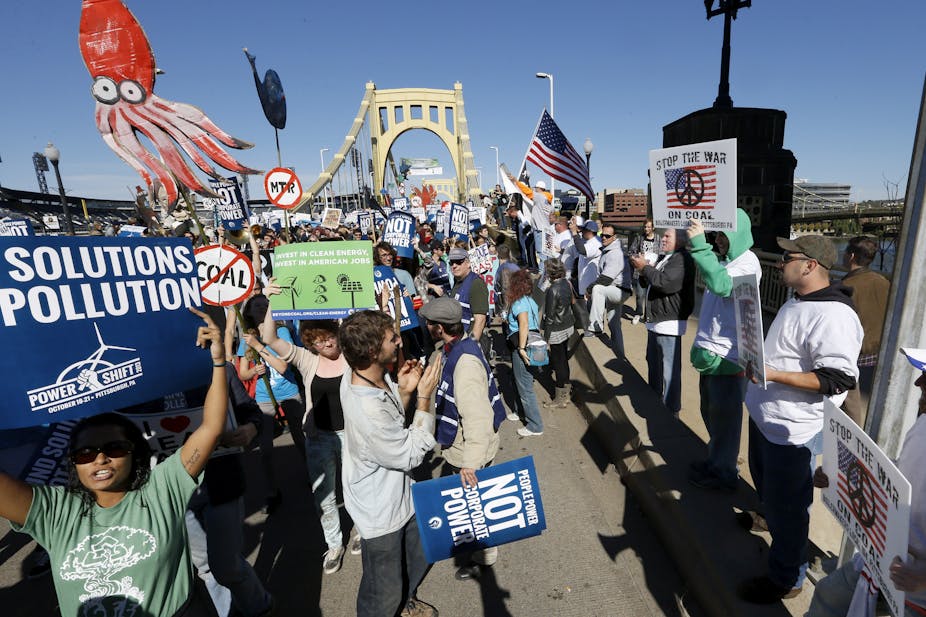Environmental issues had a marginal impact in the watershed 2016 elections, and the Trump administration is already rolling back many key climate change and resource conservation policies. These hard truths are a wake-up call for the U.S. environmental movement.
President Trump’s budget request calls for laying off one-fourth of the Environmental Protection Agency’s work force and canceling dozens of programs. Trump has also proposed deep cuts at the Interior Department, which manages public lands, and in programs to fight climate change and develop clean energy technologies at the Department of Energy. Further, the EPA has denied a petition filed by environmental groups asking for a ban on an insecticide used in agriculture, Chlorpyrifos, which inflicts very serious health damages on farming communities.
Arguably, the 2016 presidential election should have been a referendum on environmental issues. After all, the scientific case for climate change is solid. The havoc caused by major weather events such as Hurricane Sandy, which scientists say will become more frequent as climate change progresses, is obvious. The Flint water crisis has revealed horrible racial inequities perpetrated by government agencies responsible for providing citizens with clean water.

Why did these issues have so little influence? Based on our research, we believe that U.S. environmentalists are failing to persuade average voters to pay serious attention to environmental issues. In our view, the movement needs a new agenda and communications strategy to reach beyond its roots and connect with working-class voters and immigrants.
Broad support but little urgency
Environmental issues were nearly ignored during the 2016 campaign. While Democrats did talk about addressing climate change in their primaries, Republicans had nothing but scorn for it. In the general election Clinton and Trump barely mentioned the issue.
According to opinion polls, a majority of Americans were concerned about the environment and generally supported environmental protection. But November exit polls showed that these views had little influence on Americans’ votes. Clinton voters ranked foreign policy as their top priority, followed by the economy, terrorism and immigration. For Trump voters, immigration, terrorism, the economy and foreign policy were critical factors.

Why was climate change not a top issue even for Clinton voters? One reason may be that opinion polls suffer from “social desirability” bias. While poll responses are supposed to be anonymous, respondents may still try to be politically correct by supporting environmental causes, although those responses do not reflect their true feelings or actual behavior.
Moreover, poll questions are not framed to highlight trade-offs voters might have to make to fund environmental protection. It is easy to support a “free” policy that protects the environment, but respondents temper their views when they are asked to consider costs.
For example, in a recent study funded by the University of Chicago’s Energy Policy Institute, 65 percent of respondents agreed that government should do something about climate change, but only 57 percent were willing to pay as little as US$1 per month more for low-carbon electricity. Instead, many people want to free-ride and let others pay for their environmental benefits.
Environmentalism is also a victim of its own success over the last 40 years. Thanks to numerous federal laws, most Americans are now fairly satisfied with the quality of the natural environment and do not believe they need to fight for it. Only 16 percent see themselves as active participants in the environmental movement.
Regulations benefit all, penalize some
Critics argue that environmental regulations hurt the economy. Economically depressed groups are prone to look for scapegoats, and environmental regulations are a convenient target. As an example, mechanization and technical changes are the main causes of falling employment in the coal industry, but impacted states and communities tend to blame a visible target: regulations.
Republican politicians argue vigorously that regulations are “job killers.” Blue-collar unions – pillars of the Democratic Party – also oppose environmental regulations when they believe jobs are at stake, as in the Dakota Access Pipeline controversy. The United Mine Workers strongly oppose the Clean Power Plan, which President Trump has ordered EPA to rewrite or replace.
Toward a new strategy
When environmentalists call for new measures to protect resources, they should take greater account of who will bear the costs and demand that they be compensated. We call this approach embedded environmentalism.

Hillary Clinton’s Appalachia plan was an example. It offered $30 billion to aid coal-producing communities that would be harmed by the Clean Power Plan. This approach can help foster a green-blue alliance where workers and environmentalists join to protect the environment and safeguard the economic interests of impacted people.
Environmentalists also need to convince immigrants – who care most about jobs and economic security – to support environmental protection. But the environmental movement has struggled to establish a rapport with nonwhite communities. Major green groups lack diversity. People of color account for only 15 percent of the staff of large environmental organizations and do not hold top leadership positions in any of the largest groups.
Moreover, these organizations’ policies reflect the concerns of middle- and upper-class white urban voters. For example, protecting national parks and public lands is a signature issue for environmentalists, but data suggest that minorities spend less time in the outdoors than white people do.
Contrary to popular perceptions, minorities do care about environmental issues, including climate change. Environmental initiatives will sway their votes if they address local concerns – such as air and water pollution and clean drinking water – and workplace hazards, such as pesticide exposure for immigrant farm workers.
To become an influential social movement once again, U.S. environmentalists need to “go local” and pay attention to minorities’ and workers’ perspectives. Shedding urban elitism will require critical and painful self-reflection, more investment in blue-green alliances and an honest attempt to diversify the environmental movement and its agenda.
Editor’s note: This is an updated version of an article originally published on December 12, 2016.

